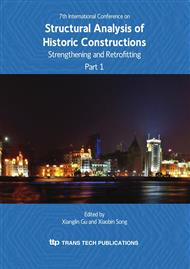[1]
Ahunbay, M Z, et al., (1997). Non-Destructive Testing and Monitoring in Hagia Sophia, in International Conference on Studies in Ancient Structures, Yildiz Technical University, Faculty of Architecture, Yildiz, Istanbul, Turkey, pp.197-207.
Google Scholar
[2]
Ansal, A A (1991). Earthquake in Istanbul, Istanbul and Earthquake Symposium, IMO-Istanbul, Turkey, pp.7-27.
DOI: 10.1201/9780203881637-34
Google Scholar
[3]
ATC (1978). Applied Technology Council, Tentative Provisions for the Development of Seismic Regulations for Buildings, ATC-3-06, Berkeley, CA, USA.
DOI: 10.6028/nbs.ir.82-2626
Google Scholar
[4]
Bozinovski, Z, and Velkov, M (1993).
Google Scholar
[5]
Cakmak, A S, Mark, R, and Erdik, M (1992). Structural Evaluation of the Hagia Sophia in Istanbul., Princeton University and Boğaziçi University, Istanbul, Turkey.
Google Scholar
[6]
Di Pasquale, S (1988). Finite Element Analysis of Masonry Domes, in Proceedings of IASS-MSU International Symposium, Istanbul, Turkey, 327-336.
Google Scholar
[7]
Durukal, E (1992). A Study on Structural Identification and Seismic Vulnarability Assesment of Ayasofya., M.S. Thesis, Boğaziçi University, Istanbul.
Google Scholar
[8]
Erdik, M, and Durukal, E (1993). Earthquake Behaviour of Hagia Sophia, in Proc. 2nd National Earthquake Engineering Conference, 10th-13rd March 1993, Istanbul, Turkey, 198-207.
Google Scholar
[9]
Erdik, M, Yuzugullu, O, and Karakoc, C (1990).
Google Scholar
[10]
Eyice, S (1978). Foundations of the Kapuagası Hüseyin Aga., Ataturk University, Faculty of Letters Research Journal, Erzurum, Turkey.
Google Scholar
[11]
Gavrilovic, P (1993). Methodology, Methods and Techniques for Repair and Strengthening of Historical Monuments, in Proc. 2nd National Earthquake Engineering Conference, 10th-13rd March 1993, Istanbul, 208-216.
Google Scholar
[12]
Karaveziroğlu, M, Barboutis, C, and Kranas, V (1997).
Google Scholar
[13]
Koçak, A (1999). Linear and Non-Linear Analysis of the Historical Buildings under Static and Dynamic Loading: The Study of Kucuk Ayasofya Mosque., Yıldız Technical University, Institute of Science, PhD Thesis, İstanbul, Turkey.
Google Scholar
[14]
Lusas, Version 11, London University Stress Analysis Program, FEA, England.
Google Scholar
[15]
Lourenço, P B, de Borst, R, and Rots, J G (1997). A Plane Stress Softening Plasticity Model for Orthotropic Materials., International Journal for Numerical Methods in Engineering, 40(21), 4011-4032.
DOI: 10.1002/(sici)1097-0207(19971115)40:21<4033::aid-nme248>3.0.co;2-0
Google Scholar
[16]
Lourenço, P B, and Rots, J G (1997). Multisurface Interface Model for Analysis of Masonry Structures., Journal of Engineering Mechanics, 123(7), 660-668.
DOI: 10.1061/(asce)0733-9399(1997)123:7(660)
Google Scholar
[17]
Lourenço, P B (2002) Computations on Historic Masonry Structures., University of Minho, Portugal, Prog. Structurel Engineering Materials, 301-319.
DOI: 10.1002/pse.120
Google Scholar
[18]
Mathews, T F (1971). The Early Churches of Constantinople, Pennsylvania State Univ. USA.
Google Scholar
[19]
Mainstone, R J (1988). Hagia Sophia: Architecture, Structure and Liturgy of Justinian's Greatest Church., London, UK.
Google Scholar
[20]
Ozaydın, K, and Yıldırım, M (1994). Investigations on the Kuçuk Ayasofya Mosque Foundation Soil, Yildiz Technical University, Faculty of Civil Engineering, Unpublished Report, Istanbul, Turkey.
Google Scholar
[21]
Ozşen, G, and Ozkaraman, M (1995). Kuçuk Ayasofya Mosque, XIIIth Technical Congress of Civil Engineering of Turkey, TMMOB, Chamber of Civil Engineering of Turkey, pp.24-26.
Google Scholar
[22]
Ozşen, G, Aköz, F, Yuzer, N, and Ozkahraman, M (1995). The Structure of Kuçuk Ayasofya Mosque -St. Sergius and Bacchus- in Istanbul, in International Symposium, Spatial Structures: Herigate, Present and Future, Milano, Italy, pp.1261-1270.
Google Scholar
[23]
Ozşen, G, Aköz, F, Yüzer, N, Ozkahraman, M, and Bayram, E (1995).
Google Scholar
[24]
Penelis, G, Karaveziroğlu, M, Styliandis, K, and Leontaridis, D (1992).
Google Scholar
[25]
Pichard, P (1975-76). The Restoration of Pagan Burma., Unesco Report RP/1975/76/3. 411. 6.
Google Scholar
[26]
Tezcan, S S (1996). Probability Analysıs of Earthquake Magnitudes., Publication of Earthquake Foundation of Turkey, Istanbul.
Google Scholar
[27]
Sheppard, P F, and Tercely, S (1985). Determination of the Seismic Resistance of an Historical Brick-Masonry Building by Laboratory Tests of Cut-Out Wall Elements, in Proc. 7th. International Brick Masonry Conference, Melbourne, Australia.
Google Scholar
[28]
UNIDO (1984). Design and Construction of Stone and Brick Masonry Buildings. " Building Construction under Seismic Conditions in the Balkan Region, V. 3, Unido, Vienna, Austria.
Google Scholar
[29]
VSL (1990). Post-Tensioned Masonry Structures., VSL International, Berne, Swittzerland.
Google Scholar


